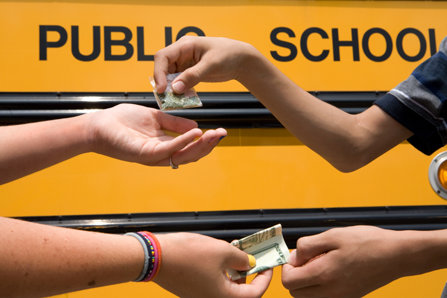What Legalizing Drugs Will Do to Perceived Risk and Young Adult Drug Use

Oregon’s recent legalization of psychedelic mushrooms for medicinal purposes is certainly newsworthy, but there is a bigger story here. The truth is, legalization tends to lead to the normalization of drug use. And some studies have shown that legalization, in the case of marijuana legalization at least, has proven to lead to a reduction in perceived risk and an increase in use.
When drugs are legalized, even if just for medicinal use, that sends the message that those drugs are in some way safe or “okay.” That has an immediate, adverse effect on perceived risk, i.e., to essentially reduce perceived risk, particularly among young people. If other states follow suit and legalize psychedelic drugs as Oregon did, how long before psychedelics are being used with wild abandon by millions of people across the United States?
Marijuana—What Legalization of Cannabis Products Did to Perceived Risk

For those who question whether or not legalization leads to a drop in perceived risk, all we have to do is examine what happened when states across the U.S. legalized marijuana. There have been numerous bodies of research done on this, particularly as it pertains to young adults’ perceived risk of cannabis.
There is no doubt that increasing legalization of cannabis has directly resulted in a drop in perceived risk regarding marijuana use.
One research project on this subject simply sought to survey young people in states that had recently legalized cannabis for recreational use. While Colorado’s survey respondents did not show any change, the results from Washington were quite different. According to the study authors, “Among eighth and 10th graders in Washington, perceived harmfulness of marijuana use decreased and marijuana use increased following legalization of recreational marijuana use. In Washington, perceived harmfulness declined 14.2% and 16.1% among eighth and 10th graders, respectively, while marijuana use increased 2.0% and 4.1% from 2010–2012 to 2013–2015. In contrast, among states that did not legalize recreational marijuana use, perceived harmfulness decreased by 4.9% and 7.2% among eighth and 10th graders, respectively, and marijuana use decreased by 1.3% and 0.9% over the same period.”
Another research paper compares the current, lax attitude towards marijuana to the 1964 Surgeon General report that condemned smoking for the immense harm that it has on health. The researchers urged caution on the subject of marijuana legalization, as smoking marijuana has many of the same harms that smoking cigarettes does. And this paper, unlike the one cited earlier, pointed out that Colorado adolescents did not experience a drop in perceived marijuana risk following legalization because their perceived risk had already dropped considerably in preceding years.
Quoting the study authors, “A different manuscript using data from the National Household Survey on Drug Use that also examined data up to 2011 reported a significant decrease in adolescent perceptions of marijuana risk in Colorado compared to non-medical marijuana states as well as a significantly higher adolescent marijuana/abuse dependence prevalence after widespread adult medical legalization.”
“... in 2019, there was a significant increase in daily use in the younger grades. In addition, teens’ perceptions of the risks of marijuana use have steadily declined over the past decade.”

The National Institute on Drug Abuse has also recorded a very concerning change in perceived risk among young people regarding marijuana. These changes seem to have occurred in tandem with the increasing legalization of marijuana, particularly in that perceived risk has dropped, most notably in states that have legalized. Quoting a NIDA paper on the subject, “Most measures of marijuana use by 8th, 10th, and 12th graders peaked in the mid-to-late 1990s and then began a period of gradual decline through the mid-2000s before leveling off. However, in 2019, there was a significant increase in daily use in the younger grades. In addition, teens’ perceptions of the risks of marijuana use have steadily declined over the past decade.”
According to that same report, about 11.8 million young adults use marijuana each year.
We can draw two important conclusions from the trend of the growing legalization of marijuana in the United States:
- The first is that, as marijuana is legalized, young people experience a reduction in their overall perceived levels of risk associated with marijuana use. They simply don’t perceive marijuana as being as risky now that it is legal.
- The second is that, as marijuana is legalized, the prevalence of marijuana use among young people increases.
Why would the above trends witnessed with marijuana be any different from the legalization of other drugs like psychedelics?
Education and Treatment—The Key to Addressing Drug Use Among Young People

According to the National Institute on Drug Abuse, properly educating and informing young people on the real risks of drugs profoundly helps in efforts to prevent use among young people. NIDA research indicates that educating young people on drugs involves creating an accurate level of perceived risk, which in turn has a direct impact on preventing them from experimenting with drugs, and helping them say no to drugs in the future.
In addition to educating young people on the risks and dangers inherent in experimenting with psychedelics and hallucinogens, it’s also crucial that we help those who are already consuming such drugs. If you know someone who is using psychedelics, hallucinogens, or other mind-altering substances, make sure they get into a residential drug and alcohol addiction treatment center as soon as possible.
We know what happens to drug use statistics when states legalize: they go up. We’ve seen this happen in states that have legalized cannabis. We should all do our part to prevent a growing legalization campaign with psychedelics. And at the same time, we also need to do everything we can to help those who are currently addicted to drugs to get off of drugs, as soon as possible.
Sources:
- https://www.oregonlive.com/politics/2020/11/oregon-becomes-first-state-to-legalize-psychedelic-mushrooms.html
- https://www.ncbi.nlm.nih.gov/pmc/articles/PMC5365078/
- https://www.ncbi.nlm.nih.gov/pmc/articles/PMC4308295/
- https://www.drugabuse.gov/publications/research-reports/marijuana/what-scope-marijuana-use-in-united-states
- https://www.drugabuse.gov/publications/drugs-brains-behavior-science-addiction/preventing-drug-misuse-addiction-best-strategy


 ®
®